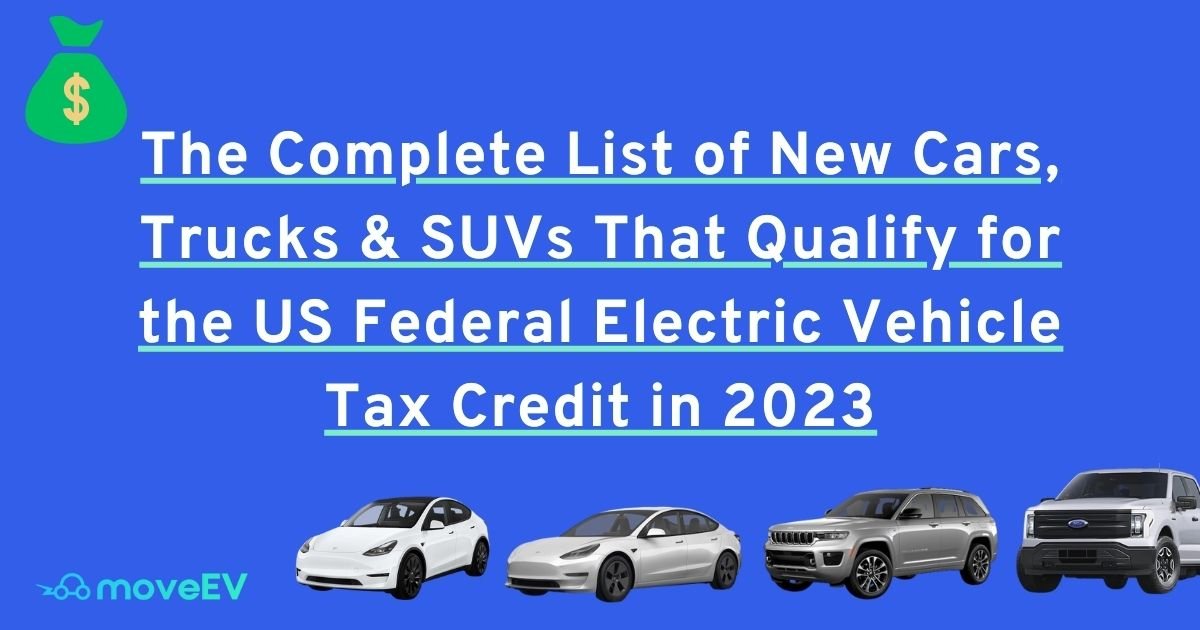Federal EV tax credit eligibility 2025? Yeah, it’s a bit of a maze, but totally worth navigating if you’re thinking about snagging a new electric ride. This year’s rules are a total revamp from previous years, with some serious changes to who qualifies and what vehicles make the cut. We’re talking stricter rules on where the car is made, what’s in the battery, and even how much you make.
Think of it as a supercharged game of “Can you qualify?” with some pretty sweet rewards for those who can crack the code.
This guide breaks down everything you need to know about the 2025 Federal EV tax credit, from the nitty-gritty details of vehicle and buyer requirements to how the changes will impact the EV market. We’ll cover the income limits, the new rules on battery components, and even give you some real-world examples of cars that do—and don’t—qualify. So grab your calculator and let’s dive in!
Vehicle Requirements for 2025 Federal EV Tax Credit
Snagging that juicy federal EV tax credit in 2025? It’s not as simple as buying any electric car. There are several hoops to jump through, relating to where the vehicle was assembled, the source of its battery components, and its sticker price. Let’s break down the specifics.
Final Assembly Location
To qualify for the credit, your electric vehicle must be finally assembled in North America. This means the car’s major components are put together in the United States, Canada, or Mexico. This requirement aims to boost domestic manufacturing and jobs. Vehicles assembled elsewhere, no matter how eco-friendly they are, won’t be eligible. This is a key factor impacting the availability of certain models.
Battery Component Sourcing Rules
A significant portion of the battery components must also be sourced from North America or countries with free trade agreements with the U.S. These rules are designed to encourage the development of a domestic battery supply chain. The exact percentages of critical minerals and battery components sourced from these regions will impact eligibility, and these percentages are subject to change and increase over time.
For 2025, the requirements will likely be stricter than in previous years, making it crucial to check the specific requirements before purchasing.
Manufacturer Suggested Retail Price (MSRP) Limits
There are MSRP limits for eligible vehicles. These limits vary depending on the vehicle type (sedan, SUV, truck, etc.) and will be adjusted annually for inflation. Exceeding the MSRP cap, even by a small amount, will disqualify the vehicle. For example, a luxury electric SUV exceeding the price cap will not qualify, even if it meets all other criteria.
So, you’re trying to snag that sweet Federal EV tax credit eligibility for 2025? Remember, it’s all about meeting those stringent requirements. One thing to consider, especially if you’re new to EVs, is how regenerative braking feels; if it’s too aggressive, you might want to check out this guide on How To Disable Ev Regenerative Braking before you buy.
Understanding your car’s features is key to maximizing your chances of qualifying for those tax breaks.
It’s crucial to verify the current MSRP limits on the IRS website before making a purchase.
Examples of Eligible and Ineligible Vehicles
The following table provides examples of vehicles that may meet or not meet the requirements. Keep in mind that these are examples and specific eligibility depends on the model year and configuration. Always check the IRS guidelines and the manufacturer’s specifications for the most up-to-date information.
| Vehicle Make | Model | Eligibility Status | Reason for Eligibility/Ineligibility |
|---|---|---|---|
| Chevrolet | Bolt EUV | Eligible (Potential) | Assuming it meets assembly and battery sourcing requirements, and is below the MSRP limit. |
| Tesla | Model 3 | Ineligible (Potential) | May not meet battery component sourcing requirements, depending on the specific battery configuration. |
| Ford | F-150 Lightning | Eligible (Potential) | Assembled in the US and may meet battery sourcing requirements, assuming it’s below the MSRP limit. |
| BMW | i4 | Ineligible (Potential) | Likely ineligible due to assembly location outside North America. |
Buyer Requirements for 2025 Federal EV Tax Credit
Snagging that sweet federal EV tax credit in 2025? It’s not just about the car; you, the buyer, need to meet specific requirements too. This section breaks down the income limits, prior use rules, and how your filing status impacts your eligibility.
Modified Adjusted Gross Income (MAGI) Limits
The amount of the tax credit, and even eligibility itself, hinges on your Modified Adjusted Gross Income (MAGI). This isn’t your simple taxable income; it’s a more comprehensive figure that includes certain deductions and adjustments. Exceeding the MAGI limits disqualifies you from the credit. The exact limits are subject to change based on inflation adjustments, so always check the IRS website for the most up-to-date information before purchasing.
Prior Use of the Vehicle, Federal EV tax credit eligibility 2025
The vehicle must be new, meaning it hasn’t been previously registered for use on public roads. This prevents people from buying used EVs and still claiming the credit. This rule applies to both the buyer and any previous owners. A vehicle previously used for personal purposes or even briefly test-driven is considered used and ineligible.
Tax Filing Status Restrictions
Your tax filing status – single, married filing jointly, head of household, etc. – affects your eligibility in terms of the applicable MAGI limits. The IRS sets different MAGI thresholds for each filing status. For example, a married couple filing jointly will have a higher MAGI limit than a single filer. This is because the income is combined when filing jointly.
Income Level and Eligibility
Understanding how your income impacts eligibility is crucial. Here’s a simplified example illustrating how different income levels might affect eligibility for a hypothetical $7,500 credit (note: actual amounts are subject to change):
The following is a hypothetical example and should not be considered tax advice. Consult a tax professional for personalized guidance.
- Single Filer, MAGI $60,000: Potentially eligible for the full $7,500 credit, assuming all other requirements are met.
- Married Filing Jointly, MAGI $150,000: Potentially eligible for the full $7,500 credit, assuming all other requirements are met.
- Single Filer, MAGI $100,000: Likely ineligible for the credit, exceeding the hypothetical MAGI limit for single filers.
- Married Filing Jointly, MAGI $300,000: Likely ineligible for the credit, exceeding the hypothetical MAGI limit for married couples filing jointly.
Remember: These are hypothetical examples. Actual MAGI limits and credit amounts will be determined by the IRS and may change annually. Always refer to the official IRS guidelines for the most accurate and up-to-date information.
Changes in the 2025 Federal EV Tax Credit Compared to Previous Years

The 2025 Federal EV tax credit underwent several significant revisions compared to its 2024 counterpart. These changes, driven by evolving policy goals and industry dynamics, significantly alter the eligibility landscape for both vehicle manufacturers and consumers. Understanding these modifications is crucial for anyone considering purchasing an electric vehicle in 2025. The alterations affect both the vehicle itself and the buyer’s qualifications, leading to a more stringent and targeted credit.The most impactful changes stem from stricter requirements regarding vehicle assembly, battery component sourcing, and consumer income limits.
These shifts aim to boost domestic manufacturing and prioritize environmentally conscious purchasing decisions. The following points detail the key differences.
Key Differences Between the 2024 and 2025 Federal EV Tax Credits
The changes implemented for the 2025 tax credit can be categorized into additions, removals, and modifications of existing rules. These changes represent a more targeted approach to incentivizing EV adoption, prioritizing vehicles assembled in North America with domestically sourced components and limiting the credit’s accessibility to higher-income individuals.
- Additions: More stringent requirements for battery component sourcing, including a higher percentage of critical minerals extracted or processed in the U.S. or countries with free trade agreements, and a greater percentage of battery components manufactured in North America. This addition aims to bolster the domestic supply chain for EV batteries. For example, the 2025 credit may require 80% of battery components to be sourced from North America, up from 40% in 2024.
This could significantly impact the eligibility of vehicles manufactured using batteries sourced primarily from Asia.
- Removals: The removal of certain loopholes or less stringent criteria that previously allowed vehicles assembled outside North America to qualify. The 2024 credit allowed for some flexibility in sourcing and assembly, which the 2025 version significantly restricts. This removal is intended to focus the incentives on vehicles produced within North America, supporting domestic job creation and reducing reliance on foreign manufacturing.
So, figuring out the Federal EV tax credit eligibility for 2025 is kinda tricky, right? A big factor influencing that will be how many people actually buy EVs, which is why checking out the projected Ev Adoption Rates In Texas 2025 is pretty helpful. Those adoption rates will impact overall demand and potentially influence future credit guidelines.
- Modifications: Changes to the Modified Adjusted Gross Income (MAGI) limits for eligibility. The 2025 credit may significantly lower the income threshold for qualification, making the credit inaccessible to higher-income households. For example, a couple’s combined income limit might be reduced from $300,000 to $225,000. This modification intends to focus the credit on middle- and lower-income consumers who might benefit more significantly from the incentive.
Potential Impact on Consumer Behavior
The modifications to the EV tax credit will likely influence consumer purchasing decisions. The stricter requirements for vehicle assembly and battery sourcing could lead to a reduction in the number of eligible vehicles, potentially resulting in higher prices for qualifying models due to increased manufacturing costs. The lower income limits will restrict access to the credit for higher-income individuals, who may choose to purchase EVs regardless of the incentive.
However, for many middle- and lower-income consumers, the changes may make EVs less affordable, potentially dampening overall demand. Conversely, the changes could stimulate demand for EVs manufactured within North America, supporting the domestic auto industry. The impact will likely vary depending on consumer income levels and the availability of qualifying vehicles.
Navigating the Application Process for the 2025 Federal EV Tax Credit: Federal EV Tax Credit Eligibility 2025

Claiming the 2025 Federal EV Tax Credit involves a straightforward process integrated into your annual tax return. Understanding the requirements beforehand is crucial for a smooth application. This section details the steps involved and common pitfalls to avoid.
Step-by-Step Guide to Claiming the Credit
The process for claiming the credit is primarily handled through Form 8936, “Clean Vehicle Credits.” This form requires detailed information about your vehicle purchase. You will need to gather documentation proving your eligibility, such as the vehicle’s VIN, purchase date, and proof of final assembly location. The IRS website provides detailed instructions and downloadable forms. After completing Form 8936, you’ll include it with your Form 1040, U.S.
Individual Income Tax Return. The credit is then calculated and applied to your tax liability, potentially resulting in a refund.
Illustrative Flowchart of the Application Process
A flowchart would visually represent the process. It would start with “Vehicle Purchase and Eligibility Check,” branching to “Yes” (meets all requirements) or “No” (ineligible). The “Yes” branch would lead to “Gather Necessary Documentation,” followed by “Complete Form 8936,” then “File with Form 1040.” The “No” branch would lead to “Review Requirements and Re-evaluate.” Decision points include verifying vehicle eligibility, confirming buyer qualifications, and ensuring all necessary documentation is included.
The final step in both branches would be a determination of credit eligibility or ineligibility.
Common Errors and How to Avoid Them
Many taxpayers make mistakes when claiming the clean vehicle tax credit. One common error is failing to meet all eligibility requirements for both the vehicle and the buyer. For example, exceeding the modified adjusted gross income (MAGI) limits or purchasing a vehicle that doesn’t meet the domestic content requirements can disqualify a claim. Another frequent mistake is providing incomplete or inaccurate information on Form 8936.
Double-checking all entries and ensuring accurate reporting of the vehicle’s specifications and purchase details is vital. Finally, failing to keep adequate records to support the claim is a critical error. Maintain copies of the purchase agreement, the vehicle’s title, and any other relevant documentation. These records are crucial if the IRS audits your return. Thorough preparation and careful review before filing can significantly reduce the chances of errors.
Impact of the 2025 Federal EV Tax Credit on the Electric Vehicle Market
The 2025 Federal EV tax credit is poised to significantly reshape the electric vehicle (EV) market in the United States. Its impact will be felt across various sectors, from consumer purchasing decisions to EV manufacturing and production strategies. The changes introduced in 2025, particularly regarding sourcing and pricing, will likely accelerate the transition to a more domestically-produced and affordable EV landscape.The increased tax credit, coupled with stricter requirements, will influence both consumer demand and the manufacturing landscape.
We can expect a ripple effect across the entire EV ecosystem, impacting everything from raw material sourcing to the final sale of vehicles to consumers. The incentives built into the credit aim to drive both sales and domestic manufacturing, creating a virtuous cycle of growth and innovation.
Effect on Electric Vehicle Sales
The enhanced tax credit is expected to boost EV sales significantly. The increased financial incentive will make EVs more affordable for a larger segment of the population, particularly those previously hesitant due to the higher initial purchase price. We can look at past instances where tax credits or rebates have spurred increased sales of energy-efficient appliances or vehicles as a strong indicator of the potential impact.
For example, the initial rollout of federal tax credits for hybrid vehicles saw a notable increase in sales shortly after the program’s launch. The 2025 credit, with its refined eligibility criteria, is anticipated to have an even more focused and impactful effect on sales. The stricter sourcing requirements, while potentially limiting the number of eligible vehicles, could ultimately increase demand for EVs that meet these standards, leading to a shift in consumer preferences toward domestically-produced vehicles.
Influence on Electric Vehicle Manufacturing and Production
The 2025 tax credit’s impact on EV manufacturing will be substantial. The emphasis on domestically sourced materials and components will incentivize manufacturers to invest in North American production facilities and supply chains. This could lead to the creation of new jobs and a boost to the domestic economy. Companies may also explore partnerships with North American suppliers to meet the eligibility criteria, fostering collaboration and innovation within the EV sector.
The potential for increased demand, driven by the tax credit, will encourage manufacturers to expand production capacity to meet the growing market need. This investment in manufacturing capacity will, in turn, lead to increased competition and potentially lower prices for consumers in the long run.
Illustrative Representation of Tax Credit Incentive
Imagine a simple bar graph. The horizontal axis represents the price of an electric vehicle, ranging from a low to a high price point. The vertical axis represents the number of potential buyers. Before the tax credit, the bar representing the number of buyers at each price point would show a gradual decline as the price increases – fewer people can afford more expensive cars.
After the tax credit is implemented, the bars representing the number of buyers for each price point shift upward. The effect is most dramatic at the higher price points, where the tax credit makes a significant difference in affordability. The overall effect is a noticeable rightward shift in the graph, showing that more people can now afford to purchase EVs at a given price point.
This illustrates how the tax credit effectively lowers the barrier to entry for EV ownership, expanding the market significantly.
Summary
Scoring that sweet EV tax credit in 2025? It’s all about knowing the rules. This year’s changes mean you need to be extra aware of where your car is assembled, what’s in its battery, and your own income level. But don’t stress! We’ve covered the key updates, income limits, and even some common pitfalls to avoid. With a little homework, you can be well on your way to driving that electric dream car and saving some serious cash.
Happy charging!









